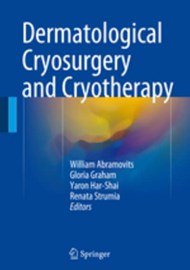This is a comprehensive dermatological cryotherapy reference book that is a useful asset to your library. With 14 sections and 143 chapters this book is a definitive guide to the use of cryotherapy in dermatology.
Starting with the history of cryosurgery Abramovtis gives a great introduction to this modality of treatment. This chapter is followed by a section specific to physics discussing the principles of cryoablation, cryogens themselves, the effects of extreme cold temperatures on our internal systems and mechanism of cellular damage. Each chapter is in-depth and deserves equal attention. This leads onto an interesting section dedicated to immunology which is a succinct chapter but postulates some important principles.
The equipment chapters are a real eye opener. I had absolutely no idea there were so many different cryo delivery systems and found this a particularly beneficial segment. Patient, lesion and method selection are well discussed alongside relative contraindications. This nicely leads onto Part VI, which focuses on cryosurgical methods from spray, cotton tip applicators and cryo-massage to cold induced lipolysis. The latter chapter is particularly interesting if you use this modality in your aesthetic practice for body contouring, however the studies are somewhat dated.
Part VII covers results, an important aspect of any type of treatment modality. Briefing patients on anticipated reactions, as well as length of time these may be present, is extremely important as the healing process does tend to create tissue damage, hence preparing patients is vital for reducing complaints. Complication prevention is always key and something every clinician strives for. This book covers both acute and chronic complications that may arise and methods to both avoid and manage them.
A large part of this book discusses individual conditions that can be managed by cryosurgery. Benign dermatological conditions are tackled first, these range from acne and callosities to haemangiomas, lichen planus and rhinophyma. Oral conditions are also well covered, making this a useful book for oral surgeons as well as dermatologists. These chapters have an introductory section which covers the disease description before going on to consider therapeutic alternatives. Only then is the actual methodology and success rate discussed.
Pre-malignant and malignant skin conditions follow suit, from Kaposi’s sarcoma and actinic keratosis to lymphoma, squames and melanoma. Again, each chapter covers disease description well before delving into management.
The final parts of the book consider socioeconomics and the future of cryosurgery. There is a short section on veterinary cryosurgery which is interesting as most definitive texts in this topic do not necessarily have a section dedicated to veterinary science.
All in all, this is a comprehensive reference text. It could do with more illustrations as at present it does make for a text heavy read. Regardless, it makes for a useful addition to your medical library if you use this treatment modality as part of your clinical practice.





